Worship of Lord Brahma, Part 19
BY: SUN STAFF
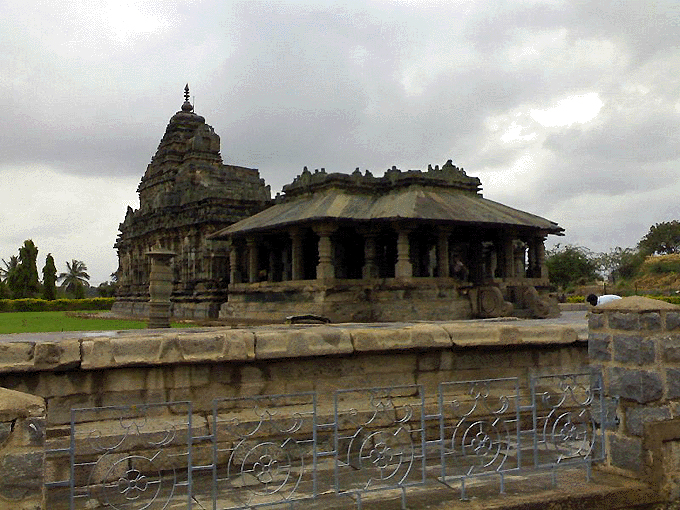
The Brahma-Jinalaya Temple at Lakkundi
Aug 25, CANADA (SUN) — A serial exploration of places of Lord Brahma's worship.
Lord Brahma in Lakkundi
In Dharwad, Gadag district of North Karnataka is the village of Lakkundi, which is home to a number of Jain and Vaisnava temples. Lakkundi (also called Lokki Gundi) is 11 km. from Gadag, on the route to Hampi (Hospet). There are more than 50 temple in the village, in varying degrees of ruin, including the Lakshminarayana, Mallikarjuna, Virabhadra, Manikeshwara, Nanneshwara, Someshwara, and Nilakanteshwara temples, among many others. There are also more than 100 stepped wells, called kalyani or pushkarni.
The temples, tirthas and tanks in Lakkundi were built during the reign of the late Chalukyas, Kalachuris, Seuna and Hoysalas. The Chalukyas took power from the Rashtrakutas during the late 9th century and made Kalyani their capital. A great center of Chalukya art, there are a number of very important architectural sites found in the area. These include the Kasivisvesvara temple and the Jain Brahma-Jinalaya, one of the oldest shrines at Lakkundi. A beautiful catur-mukhya Brahmadev murti found in the Brahma-Jinalaya temple is the focus of today's segment.
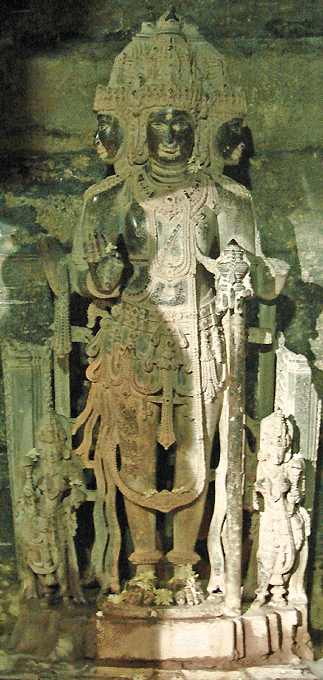
Chaturmukha Brahma, Brahma-Jinalaya Temple at Lakkundi
Jain Philosophy
In order to understand the significance of Brahma worship in the Jain sect, we should first consider the relationship of Jainism to Vaisnavism. Like Buddhism, Jainism is considered to be a 'reform movement', having separated from the main body of Hindu religious tenets to become an independent religion.
The word 'Jain' means 'victor' or 'conqueror', referring to one's final victory over bondage to material life. The fundamental tenet of Jainism is non-violence. The Jain's philosophical evolution away from the worship of Lord Krsna as the Supreme Creator is said to have been the result of their desire to distance themselves from the contaminated priestly order of Brahmanism that reigned at the time, and which offered a particular representation of the Vedas and Upanishads. In this regard, the break-away of the Jains is somewhat like the genesis of Buddhism.
While the sect was founded much earlier, Jainism became prominent during the time of Mahavira, who was born into a Hindu family around 599 BC in the town of Vyshali, in present day Bihar, North India. Mahavira has been deified by the Jains, and their sastra declares him to be the last of 24 tirthankaras, or perfect souls.
Because of their focus on non-violence, the Jains distanced themselves from Sri Krsna and His non-pacifist pastimes. Instead, they took up the concept of Baladeva, Vasudeva and Prati-Vasudeva to solve their philosophical dilemma.
The Jain list of sixty-three Shalakapurshas or notable figures, includes amongst others the twenty-four Tirthankaras and nine sets of the Baladeva/Vasudeva/Prati-Vasudeva triad. Krishna is accepted as Vasudeva, Balarama as the Baladeva, and Jarasandha as the Prati-Vasudeva. The Jain sastra explaining their conclusions in this regard include the Harivamsha of Jinasena (not be confused with the addendum to the Mahabharata) and the Trishashti-shalakapurusha-charita of Hemachandra.
In each age of the Jain cycles of time, Vasudeva appears along with His elder brother, Baladeva. Prati-vasudeva fills the role of the demon, while Baladeva upholds the Jain principles of non-violence. Vasudeva, however, must forsake this principle and kill the Prati-Vasudeva, to save the world. Vasudeva is then believed to descend to hell, as punishment for this violent act. Once his penances are paid, he is reborn as a Tirthankara.
Aside from this unique permutation of philosophy, the Jains generally accept many of the fundamental tenets of Vaisnavism, and images of the Trimurti are often found in their temples, in various forms, including the Caturmukhya Brahma described below.
Lakkundi Temples, Shrines and Tanks
Along with the Lakkundi temples mentioned above, some of the other most notable temples are the Halagunda Basavanna Temple, Nadayadeva Temple, Nagaradeva Shrine, Suryanarayana Shrine, Vishwantha Temple, and Virupaksha Temple. Many temples are dedicated to Lord Siva and his various aspects.
The majority of temples and shrines at Lakkundi are constructed of green schist, with highly ornamented outer walls and doorways. The shikharas are a modified type, while the parapet and pilastered walls are typical of the South India style.
While a number of references are found referring to the Brahma temple at Lakkundi as being the Manikesvara temple, in fact the prominent Brahma murti is housed at the Brahma Jinalaya temple, not the Manikesvara temple.
The Brahma Jinalaya temple was built by Queen Attimabbe, and is the largest of the many Jain temples in Lakkundi. Dedicated to the Jain saint Mahavira, this temple, or basadi, is one of the earliest examples of in the area of buildings constructed of the finely textured chloritic schist, which greatly improved upon the typical sandstone constructions of the region. Because the schist came out of the quarries in thinner slabs, the resulting sculptures crafted in it were generally smaller and more delicately and ornately carved.
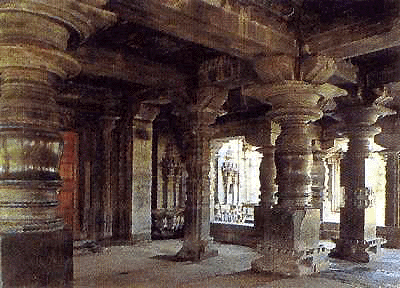
Inside the Open Mandapa of Brahma Jinalaya
The Brahma Jinalaya temple, built in the late 11th century, has a five-story vimana, with square base to the sikhara. It originally had a closed square navaranga in front, but an mandapa was added later on in the front. The open hall has central pillars decorated with beautiful sculptures. The Garbagudi holds the idol of Vardhamana Mahavira Tirthankara.
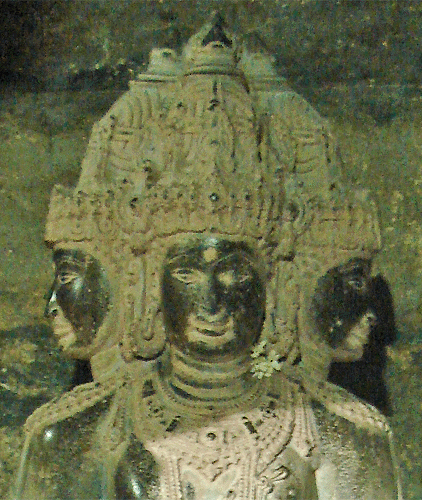
Chatur-mukha Brahma
The murti of Lord Brahmadev at Brahma Jinalaya temple is exceptionally beautiful and imposing. The murti is catur-mukha, four-faced, carved of the same schist as the temple itself. Lord Brahma's faces are polished, resulting in an interesting dark-faced contrast to the rest of the murti. His front hands are holding mala and lota, and it appears that the hands have broken off the two side arms. Brahma's consorts, Savitri and Gayatri, stand at his feet.
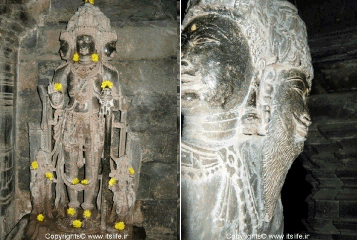
Chatur-mukha Brahma
Nearby Brahma Jinalaya is the Manikesvara temple, and an amazing stepped tank. The tank steps descend on three sides, and it is flanked on both sides by smaller shrines. The approach to the mandapa of the two flanking temples forms a bridge, which approaches the fourth side of the tank
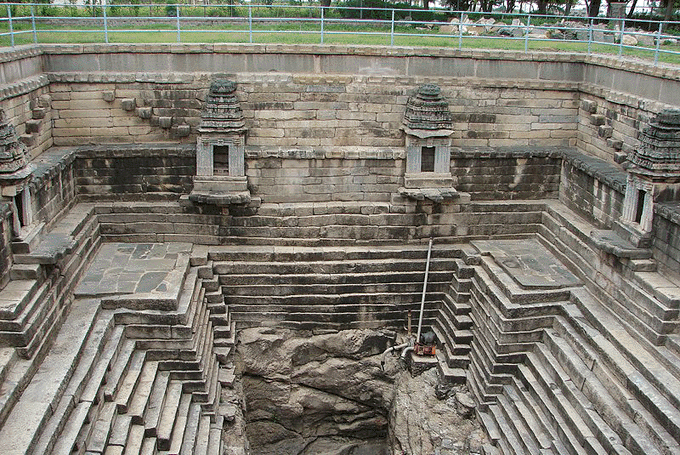
Manikesvara Tank
In tomorrow's segment, we'll look at a few more examples of Lord Brahma murtis in the Jain tradition.

The Sun
News
Editorials
Features
Sun Blogs
Classifieds
Events
Recipes
PodCasts
About
Submit an Article
Contact Us
Advertise
HareKrsna.com
Copyright 2005, HareKrsna.com. All rights reserved.
